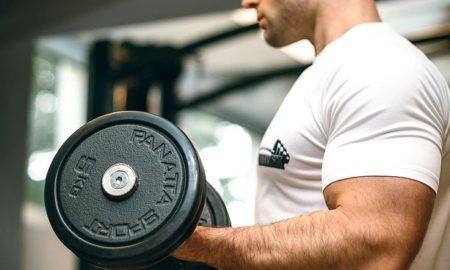

Are you planning to bulk up this winter but need help figuring out where to start?
This article discusses how you can bulk up your body muscles this winter and gives tips for growing your muscles.
First, let us go into what bulking is so you can learn how to build and maintain your muscles over this winter through 2023!
What Is Bulking?
Bulking is a nutrition strategy aiming to maximize lean muscle mass and strength by taking in more calories than you usually consume and doing frequent exercises for a specific period.
This extra food intake will fuel your body and encourage muscle growth. To do this, you’ll need to master your daily caloric intake, macronutrients, and workouts.
Bulking is a common goal for bodybuilders and fitness enthusiasts who want to improve their appearance, increase muscle mass, strength and size and boost energy levels. Many people also use bulking to lose body fat and maintain an impressive physique or fitness.
How to Bulk
When commencing a bulking session, consider your bulking goals— how much lean muscle mass you want to build, how long you will need to accomplish it, and what muscle-to-fat ratio you want.
After determining the number of calories you can consume each day without gaining or shedding weight, increase your daily caloric intake by 250 to 500 per week, based on how extreme you wish to be.
Increasing the amount of your daily calorie consumption will result in gaining body weight quickly. However, you’ll likely experience minimal benefit when adding more muscle. According to research, consuming a modest excess of 300–500 more calories daily is enough to gain healthy muscles.
How Does Bulking Work
Bulking is a strenuous activity on your body. Fortunately, calories are essential in providing energy to ensure the process takes place.
For bulking to occur, you need to be in a caloric surplus state to enable your body to be in an anabolic state. You have to consume more calories than your body burns daily (Caloric surplus) to supply your body with enough energy to build and repair muscles.
The more calories you consume, the more fuel you have, and the lower the risk of entering a catabolic state.
The caloric surplus state is consuming more calories than what your body burns daily, while the anabolic is a state where your body has enough energy and fuel to build and repair muscles.
When you’re not eating enough calories or eat the same amount of calories your body burns daily, your body enters into a catabolic state. In this state, it begins breaking down muscles for energy instead of building them up and using non-carbohydrate sources like proteins to get energy— which cannot create muscles.
A good rule of thumb is to eat at least 1.6 grams of protein for every kilogram of body weight daily.
Working out in a catabolic state can stress the body, producing cortisol hormone, which lowers testosterone levels and can cause muscle breakdown; therefore, instead of creating muscles, you may reduce muscles.

Right Training
The next thing is to turn the extra calories into muscles with proper training. Heavy strength training mixed with classic bodybuilding workouts is the best-recommended training.
When strength training, you induce muscle damage; as a response, your body begins the muscular repair and growth process called muscle protein synthesis. During this process, testosterone and insulin-like factor-1 hormones, which support tissues and bones development and growth, signal satellite cells—the forerunners of skeletal muscle cells—to travel to the wounded muscle and begin protein-rebuilding, promoting bulking.
You can add high-intensity interval training to your training as they will help to reduce the weight you acquire when bulking that comes from fat. Interval exercise also appears to boost muscle protein synthesis and, as a result, can help reduce body fat while increasing muscle mass.
Low-intensity training is not recommended for bulking as it does not enhance muscle growth; instead, it reduces whatever you may have that could calorie surplus be used to increase muscle mass. If you must do low-intensity workouts like cardio, take as little time as possible to avoid losing calories.
On top of your training, you also need to watch out for your recovery. As much as you are training correctly and eating more to bulk, you also need to dial on your recovery. Prioritize things like taking an ice bath, having a night of quality sleep, drinking water, and doing light exercises ( active recovery) for your body to repair and build muscles.
Bulking Diet
As much as you increase calorie intake, you should ensure your nutrition contains sufficient carbohydrates, healthy fats and proteins. Proteins are building blocks for muscle gain, while carbohydrates affect resistance training performance which is also essential for clean bulking.
You need to get as much protein as possible in your diet. The more protein you can eat, the better your results will be. The primary protein sources are meat, fish and eggs, soybean products, legumes (beans), and nuts.
Clean bulking also requires watching what you eat— you don’t eat just any food for the sake of adding weight. You should embrace organic, unprocessed, and whole foods high in fiber, such as veggies, fruits, and lean meat containing little saturated fat.
Avoid foods such as processed foods, saturated fat-laden meats, foods with added sugar, sweets, trans fats, and even fast food, as they do not promote muscle gain and are also unhealthy for your health.
Once you know the foods you need to consume, calculate the number of calories you have to eat every day to achieve your aim of growing lean mass.
Most people require a daily calorie surplus to gain weight from 0.5 to 1.5 pounds per week, increasing to 2 to 6 each month. For women, this implies consuming an extra 250 to 500 caloric intake per day throughout the bulking period. However, you can eat more than that, depending on your metabolism.
To determine your daily caloric intake depending on your age, weight, height, sex, and degree of activity, there is a simple online calculator that you can use—all you need to do is key in your information.
Start incorporating the calories slowly to attain your new set of caloric goals. You may start by ensuring you eat up to the total capacity for every meal you take or adding one more serving to your lunch, breakfast, and supper. If the two don’t work for you, try monitoring your macros and calories, which is the logical way.

The Macros in Bulking
The number of calories you consume dictates your weight growth rate, but the content of those calories influences the quality of this same weight.
All macronutrients are crucial, but a lack of protein can swiftly damper your gains — since amino acids are the structural components of protein tissue required for growth and repair. So ensure you consume sufficient protein.
Carbohydrates and fats are also essential macronutrients. Although dietary fat is less crucial for muscle development than protein, it is the highest calorie-rich macronutrient. It has nine calories for every gram, making it a highly efficient and effective way to reach your calorie target.
It’s also significantly less filling than protein. It’s found in most meats, avocado poultry, coconut cream, nuts, and dairy foods. Remember to use the online calculator to track your calorie and macros intake.
Some people may find it challenging to eat the recommended quantity of protein daily in whole-food foods while bulking. Protein supplements can help with that.
Include a protein shake supplement to create delicious mid-meal snacks. Aim to incorporate roughly 25 g of protein shakes supplement per serving in your diet. Some of the supplements you can take include.
- Creatine Monohydrate
- Multivitamins
- Protein powder
- Mass gainer
- Whey protein
Additionally, it would help if you don’t restrict your protein shake solely for use in your post-workout regimen. Consume a lot of protein spaced out throughout the day when bulking. You may take your protein shake just after your training, during breakfast, or before night to avoid catabolism, a crucial repair process for the body that occurs while sleeping.
Bulking Workout Routine
You need to work out and lift heavy weights regularly. In the case of bulking, heavy weight lifting (strength training) combined with regular (traditional) workouts can help you achieve your goal.
Low-intensity workouts do not facilitate muscle growth or building, but they can help to keep your heart healthy.
Your daily routines will vary depending on how much time you dedicate to lifting weights. If you can barely exercise four days per week, it is essential to do a full-body workout each session to strike all muscles repeatedly, which is a crucial step in making your muscles grow.
Work out your muscle group differently if you intend on five or more exercises a week. For instance, you can train your shoulders, back, core, legs, and arms separately.
How Long Does Bulking Last
Despite a correct calorie surplus, keep your expectations for muscle building in restraint. The length of time a bulking last varies depending on the individual reasons for bulking.
Those new to weightlifting may see improvements faster than an expert since these adjustments are a totally new stimulus to their body.
When you introduce strength training and consume more nutrients and calorically dense foods, your body can start to activate, and you build muscle a little quicker than someone who has been training for extremely long periods. This is because the body of experts has already developed a significant amount of the adaptations.






















You must be logged in to post a comment Login